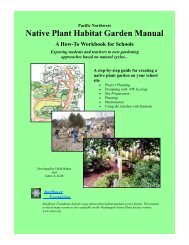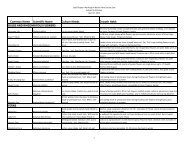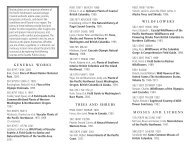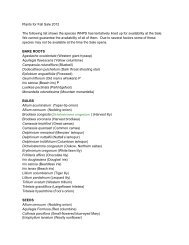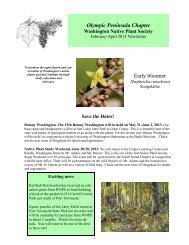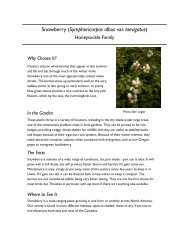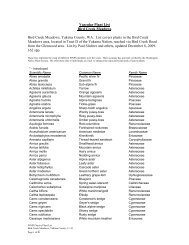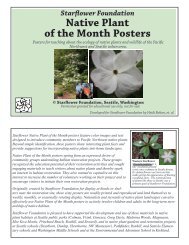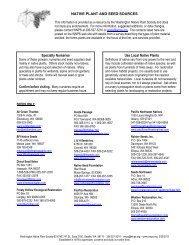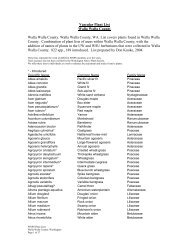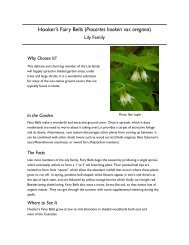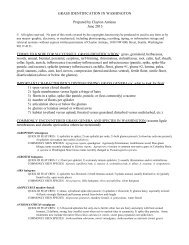Quick & Easy Habitat Education Activities - Washington Native Plant ...
Quick & Easy Habitat Education Activities - Washington Native Plant ...
Quick & Easy Habitat Education Activities - Washington Native Plant ...
You also want an ePaper? Increase the reach of your titles
YUMPU automatically turns print PDFs into web optimized ePapers that Google loves.
<strong>Quick</strong> & <strong>Easy</strong> <strong>Habitat</strong> <strong>Education</strong> Activity DescriptionsFourth Grade Theme: Examining wildlife habitat and the ‘Web of Life’4-1 Animal Survival Skills Students learn skills for observing wildlife in the habitat project by imitating wildlife survival techniques, while also practicinggood outdoor etiquette. These skills help students to move quietly, and to see and hear more clearly. They are alsohelpful for managing student behavior while visiting habitat areas.4-2 <strong>Habitat</strong> Hunt Students work in teams to find the important wildlife habitat components required by different wildlife species that areknown to use the types of habitat area being visited. Students evaluate this information to assess the habitat potential fora particular species. They then consider ways that new habitat components might be introduced as part of a restorationproject to improve the habitat for specific animals.4-3 Wildlife Sign Walk Students learn how to look for evidence of wildlife in a natural habitat area by studying images of different types ofwildlife sign. They walk through the natural habitat, making field observations and looking for wildlife sign, then recordwildlife sign through drawing and journaling.4-4 Cycle of RenewalDrawingsStudents learn that the habitat area is a complex system through drawing, imaginative role playing and exploration. They gainan appreciation for tiny organisms and soil, as well as for larger plants and animals. Students develop appreciation for thehabitat components which will be important as they conduct other activities in the habitat area.4-5 Life in the Forest Floor Students explore woody debris to find evidence of wildlife and plants that live in the decomposing material on the forest floor.Students use magnifiers to see this evidence then examine and explain the importance of woody debris in the cycle of renewalof the habitat area. This activity is designed to follow Cycle of Renewal Drawings.4-6 <strong>Habitat</strong> Features- EachOne Teach OneStudents participate in a hike during which they become ‘the teachers’. At teaching stations, student teams teach their fellowstudents interesting facts about one habitat feature in the forest and are active learners themselves. The technique forinstruction models “leap frog learning” where students learn by teaching.4-7 Ecosystem Explorers Students go into a habitat area to learn about, identify and explore ecosystem components. Students go on a scavengerhunt to find and identify evidence of components, and then draw this evidence. These drawings are used in the Web of Lifeactivity, which follows, to create a ‘web of life’ for the habitat.4-8 Web of Life Students use drawings created in the Ecosystem Explorers activity to create a model of their ecosystem and to show howthe components of an ecosystem depend upon each other. By looking at this interdependence, students increase theirawareness of the importance of individual species or elements of the habitat area in maintaining a healthy ecosystem.4-9 Ethnobotany Story Students learn about native plants and their uses for food and shelter by <strong>Native</strong> Americans. Students use this knowledge to‘survive’ while enacting an ethnobotany story.4-10 Ethnobotany Snack Plate Students participate in making a snack food plate from native plants, while learning about the plants which are the sourceof these foods. This activity helps students understand that humans also depend on natural habitat for survival.<strong>Quick</strong> & <strong>Easy</strong> <strong>Habitat</strong> <strong>Education</strong> Activity DescriptionsFifth Grade Theme: Designing and participating in stewardship activities5-1 Restoration Bag Students develop a ‘habitat restoration ethic” and learn about the tools and practice of a scientific restoration study bylooking at and discussing various relevant objects. This activity is to be implemented prior to visiting restoration site.5-2 Four Direction Walk The students go to a habitat site and get the “lay of the land’ by locating the four cardinal points- N, S, E, W. Studentsplace the cardinal points on site maps and discuss why this information is important when studying an ecosystem.5-3 Four Direction Plots Students form teams to select and layout observation study plots in the habitat area which will be used for ongoingobservation and monitoring stewardship activities. Students create a plot map and mark the four directions on their map.Students begin to journal about their plots.5-4 Restore a <strong>Habitat</strong> I-Ecosystems5-5 Restore a <strong>Habitat</strong> II-Forest SuccessionStudents learn about the Westside Lowland Forest ecosystem, the concepts of plant communities and plant layers, whileviewing images. Students assess their plot and determine its plant community as they consider the goals of habitat restoration.Students study a forest restoration area in the habitat site and visualize its growth in 5, 25 and 100 years. Students drawsuccession drawings reflecting their predictions. This activity helps students understand restoration potential over time andthe role of succession in habitat restoration planning.5-6 <strong>Plant</strong> Assessment Students assess the existing vegetation found on their plots and evaluate their plots for native and non-native plant cover.Students build plant identification skills and collect information useful for future monitoring activities.5-7 Soil Assessment I-Composition5-8 Soil Assessment II-HydrologyStudents conduct tests to assess soil composition from their study plots and from different plant community types in thehabitat area. They compare data and draw conclusions about their results. To reinforce the learning experience and toshare equipment and data, consider working with other classes who are studying the ‘Soils’ science kit.Students use soil samples collected in the Soils Assessment I activity to study how soil composition affects water flow, andconsider how differences in soil composition have an effect in the habitat area. <strong>Activities</strong> integrate directly with the ‘Land& Water’ science kit, using the plots and habitat area as ‘real world’ examples.5-9 Monitoring Inspiration Students consider how to determine if a habitat area is healthy, or if a restoration project is successful, and how thisinformation might be gathered and shared with others. Students review suggested monitoring activities and develop a planto set up monitoring activities for their plots. Students decide how they will share this information with others in the formof a report or presentation.5-10 Monitoring Stations Students implement their monitoring plan as developed in Monitoring Inspiration by setting up several different types ofmonitoring stations in the habitat area and beginning monitoring activities. Students return to stations over a period of timeand record information which can be used in reports about the habitat area.



